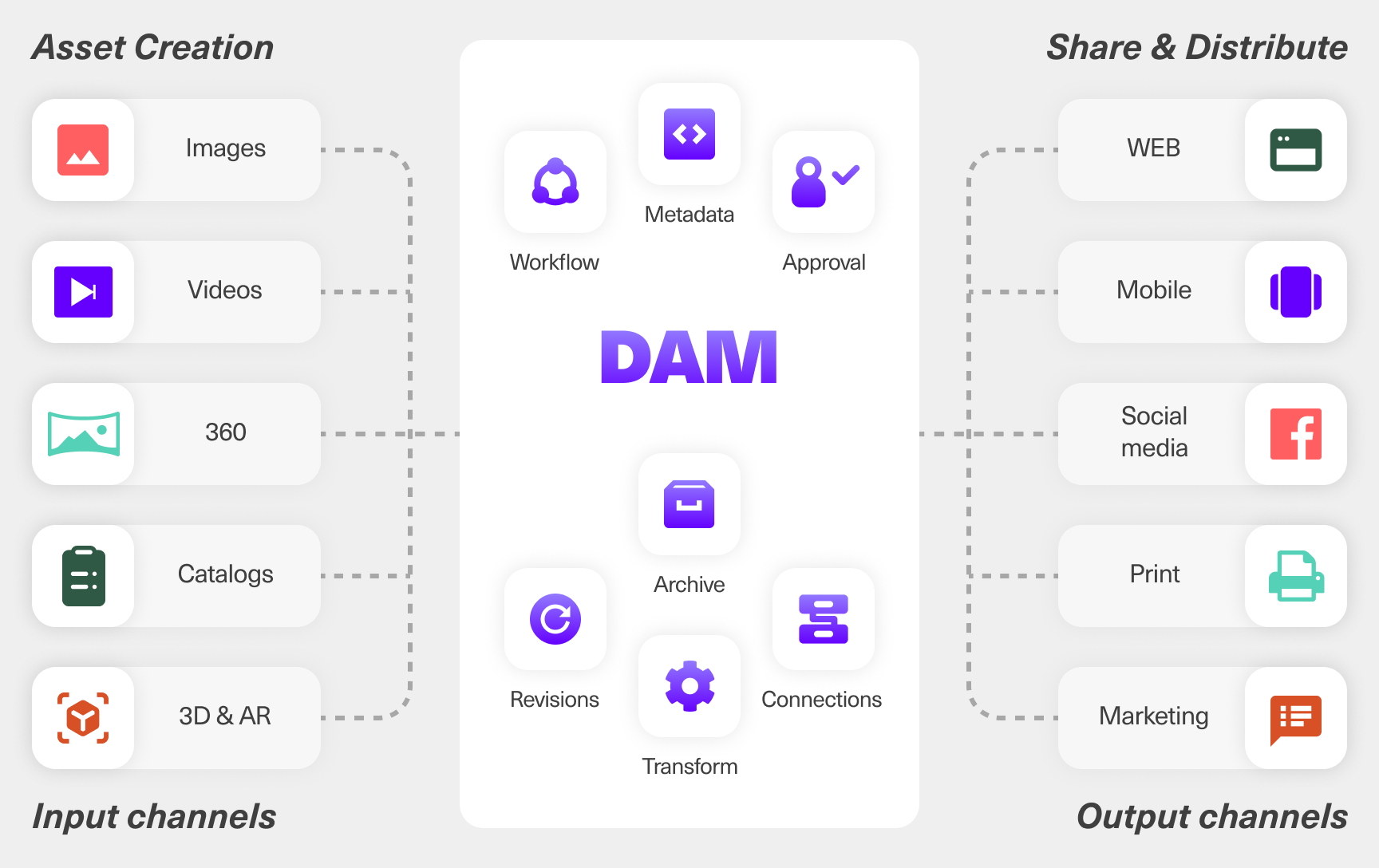What is a DAM system?
DAM System (Digital Asset Management System) is a digital asset management software that implements storage, quick search and easy access to all media data for any authorized team member.
The platform is used as a single place of collection of all media content, as a marketing asset for your business, where all the components of your brand are relevant, up-to-date, accessible and always ready to be transferred in the required format, regardless of the sales channel.
DAM makes it quick and easy to deploy a digital library by providing controlled access to documents, images, media, audio, and video. And also ensure the security of data exchange with employees, suppliers, contractors, customers and other market members.

What product information is managed by Digital Asset Management?
DAM works with any formats of media data. For example, in the DAM system, you can view and work with logo previews, photos, 3D photos, videos, 360 photos, rich content, diagrams, VR, PDF files, infographics, documents, and almost any file format you choose to download.
All your media assets can be organized into a multilevel folder structure with an intuitive hierarchy that you can create to match your requirements.
Files can be categorized into one or more categories, individually added to collections that you can choose to share. You can set exact dates of availability for each media asset, so they will only be available for use when the brand needs it.
Each media asset can include a complete set of metadata. Metadata can be added and modified on a per-asset basis or added as a whole via CSV upload. SKUs and EANs can link assets to your products in PIM system for automatic distribution across channels.
Basic search can return results by titles, keywords and categories. Advanced search allows you to perform detailed multi-line queries on asset parameters and metadata through a clear and easy-to-use interface.
What can be done with a help of Digital Asset Management?
The platform provides wide range of opportunities for the exchange and control of your digital assets. The system allows you to share your images, videos, documents or 3D/AR data either with password protection or using a short link that has a certain expectation date. You can update your assets at any time and distribute only the latest version of the files.
You can define your own media asset creation process with numerous options from simple CSV import to automatic synchronization with existing ERP, CRM, CMS systems via API.
The digital asset management workflows on the platform can be customized to meet your own requirements for the approval process, including checking asset quality, avoiding duplication, and ensuring that all required metadata is complete.
What are the benefits of DAM?
Teamwork
Users can access digital assets (Digital Assets) in a single repository from anywhere in real time. You can give your teams an access, regardless of their region or time zone, to find what they need, when they need it, reducing two-way communication while increasing their productivity on the other hand.
Brand consistency and integrity
You can centrally manage digital assets, update and reconcile visual content and marketing materials, which resulting in consistent quality and style, and preventing unapproved or outdated assets from being used. As a result, your brand image becomes stronger, more harmonious and more professional even when you work with multiple contractors.
Efficiency
Using the platform in conjunction with PIM improves productivity and efficiency by saving time spent searching, configuring, and managing digital assets so designers can focus on key content creation tasks. Collaboration becomes seamless and fast, especially by eliminating time-consuming design requests and two-way communication.
Safety
Security considerations make sharing files such as images and videos via email problematic. By setting access rights to DAM system assets, you can confidently control who and how has access to a particular files.
Asset usage analytics
With file performance analytics, you can make informed decisions for campaigns targeting media. You can also see which assets are used the most in campaigns and which ones perform well. The platform includes a link to PIM, aggregating tools, comparing and interpreting data from multiple sources.
Scalability
Project growth due to the constantly growing number and variety of media assets that accompanies business growth is not a problem for a DAM system due to the ability to handle a large volume of assets, users and a multi-layer architecture of platform uptime.
How can your company use a DAM system?

Internal users
Sales and Marketing
The DAM system, together with PIM (Product Information Management), facilitates collaboration between sales representatives and marketing teams by providing them with access to a centralized source of relevant media assets for presentations. Marketing teams constantly create media assets sets to promote the company and maintain brand integrity. A key responsibility of marketing is to share creative files with agencies, internal stakeholders, or media contacts for media. At the same time, a centralized management system saves sellers a lot of time and energy, allowing them to focus on what really matters: attracting customers and increasing sales.
Designers and content production
In-house content professionals such as photographers and graphic designers can upload new content and access branded materials and manage digital assets at any time from anywhere in the world. Creative teams use the platform to improve workflow efficiency. Most media assets come from copywriters, photographers and designers.

Development Team
Tech teams need a simplified path to access media assets and their metadata. DAM/PIM has a reliable API with which you can integrate all of your critical elements of your internal enterprise software structure. Tight integration with your content management system lays the foundation for the content of your omnichannel communications and customer interaction. This allows website editors to easily find web-friendly digital asset formats for creating websites, landings and mobile apps, product pages on marketplaces and online catalogs.
Lawyers
DAM systems help enforce rules and regulations by organizing and classifying media assets. For example, marking resources with expiration dates prevents obsolete items from being used. A digital asset management system helps maintain the availability of certificates and permits, as well as monitor their relevance. Before approving the placement of media assets, the legal department must ensure that images and videos comply with laws, company and brand policies.

External Users
Partners and contractors
Your company can work with external partners and contractors to develop products and to strategize and implement marketing campaigns and services. In addition, DAM systems ensure the security of company assets, brand integrity and compliance.
Clients
In some cases, clients need to be granted access to manage digital assets for projects or services. For example, sales reps can easily share media assets with external contacts such as customers and potential partners.
Agencies
With the DAM system you can easily share, access, edit assets, store and transfer files for review or approval by the client. The platform brings teams together in a single environment, reducing complexity, eliminating inconsistency, and encouraging collaboration. It serves as a repository of creative resources along with recommendations and guidelines for using resources for client brands. DAM can be used to manage a large number of files - brand assets of different clients for different channels, audiences and campaigns.
Main features of DAM systems:
Powerful infrastructure.
The infrastructure of a digital asset management system provides the ability to quickly transfer and storage files, which are key conditions for high performance and asset protection. Flexibility, scalability, reliability, high availability and redundancy are of paramount importance.
Third party integrations.
Third party tools include content management systems, social media and cloud platforms. The DAM system architecture and API support allows you to centralize digital asset management processes with which you can handle various types of files and media, not to mention new and old applications and repositories.
Support for multiple formats and sources.
With an ever-growing range of content sources, DAM offers broad spectrum of support for a variety of formats, destinations, and consumer types. For instance, unstructured data such as multimedia files, scanned documents, digitized images, and electronic forms.
Support for asset lifecycles and user roles.
DAM works well with different types of content from all users. You can automate file routing and map functionality to user roles. Throughout the lifecycle of an asset, teams can seamlessly collaborate on a cloud platform with a single, lossless repository between media asset development and content delivery. This consolidation of disparate processes and functional groups effectively complements marketing and advertising campaigns.
What business formats can the platform be used for?
DAM is not just for big manufacturers. Small businesses in a number of sectors are increasingly incorporating this solution into their business strategy. In addition, including such software in your company’s business plan shows potential partners and investors that your business has the perfect system support that will be reliable and productive.
Any company or agency that uses High Resolution Pictures, files, or video to interact with clients often uses a DAM system.
Online product catalogs, real estate listings, 3D models and graphics for marketplaces, social media content are just some of the common digital assets that a PIM/DAM system can help your team work with effectively.
Any business format, any company can benefit from efficient and consistent collaboration between its employees. With digital-centric PIM/DAM, creatives and sales teams can use one modern platform that simplifies workflows and ultimately improves the end-user experience.